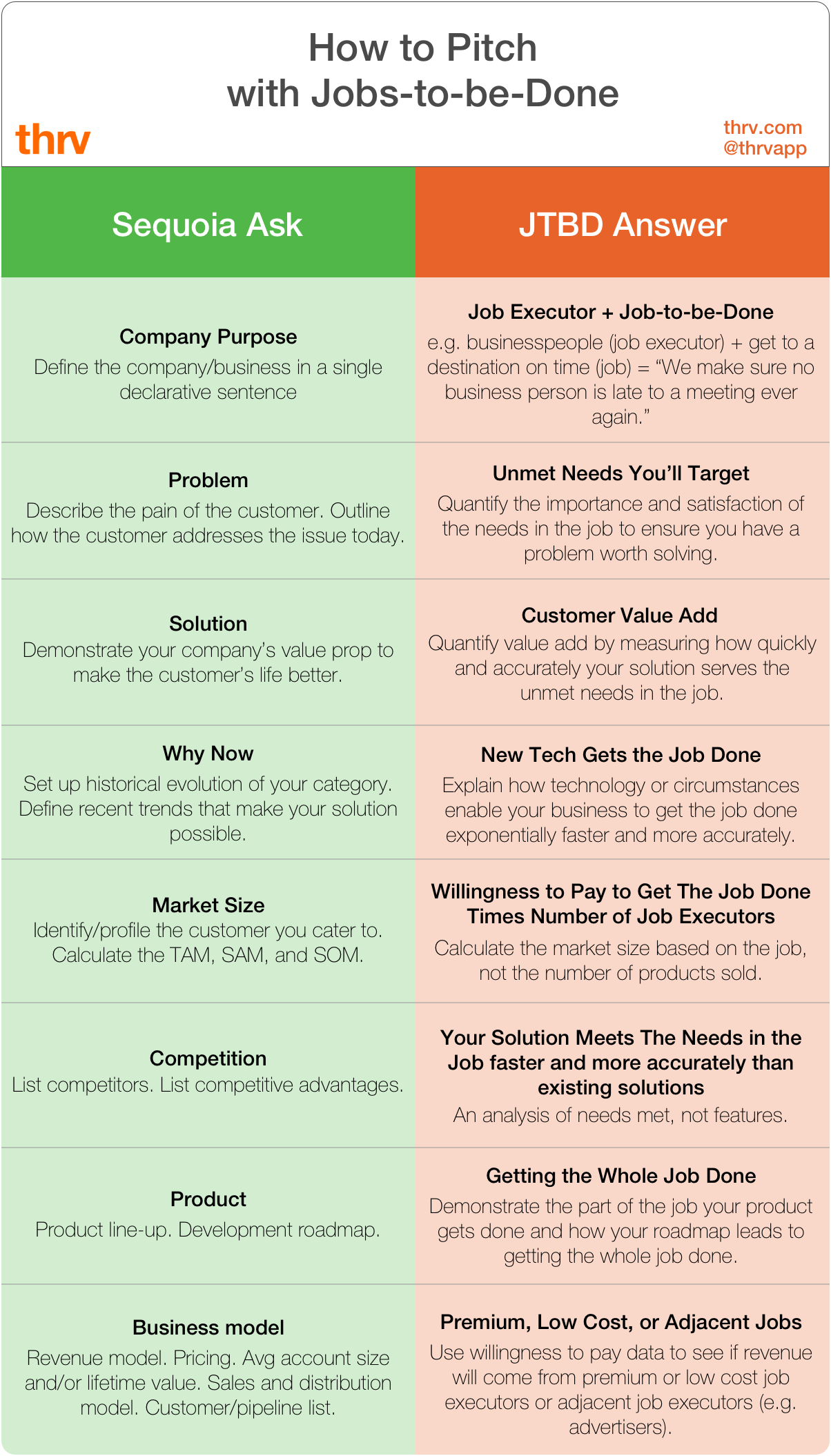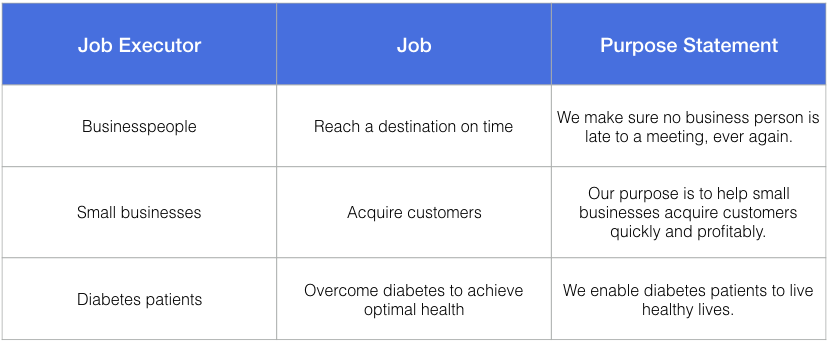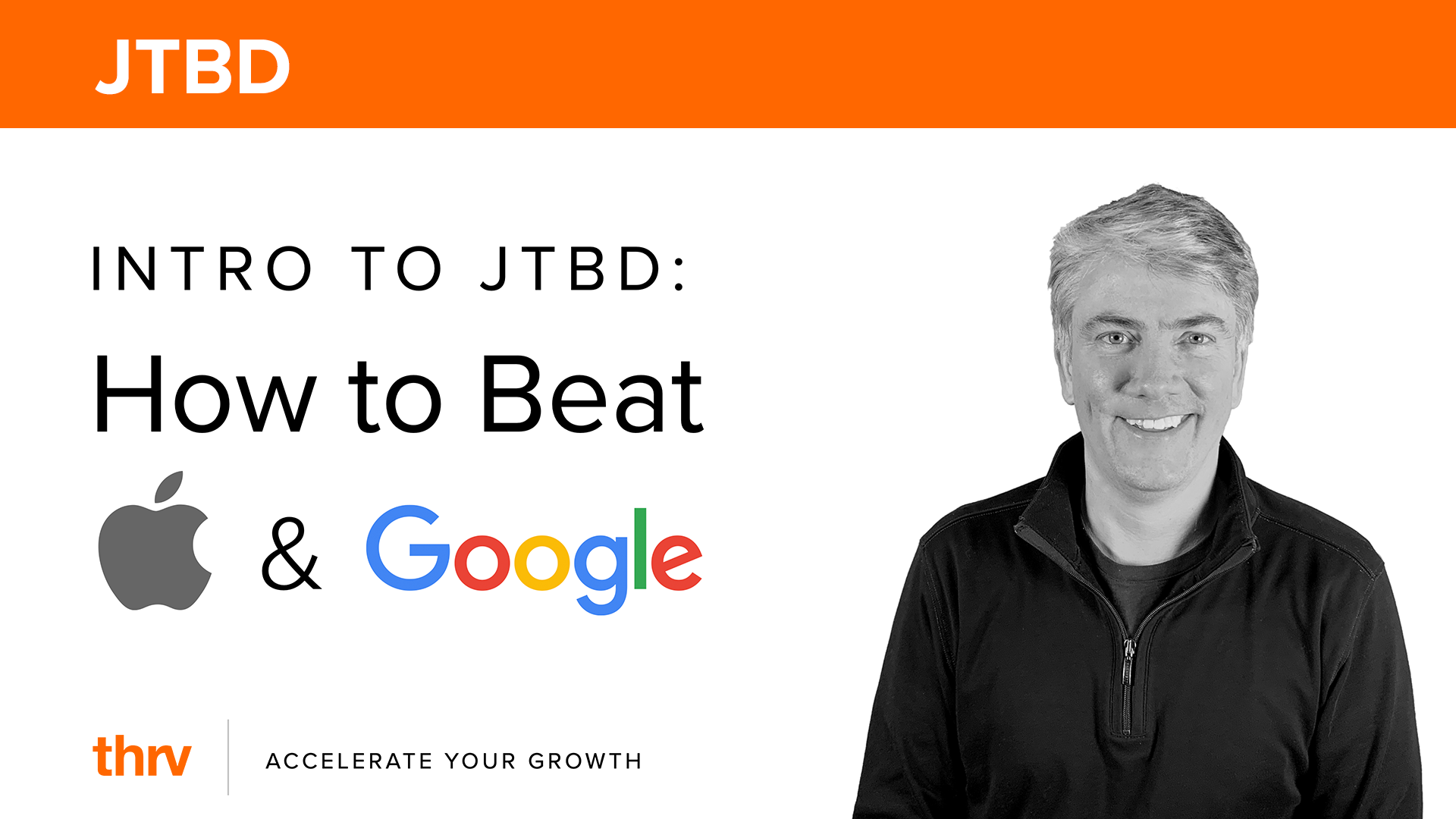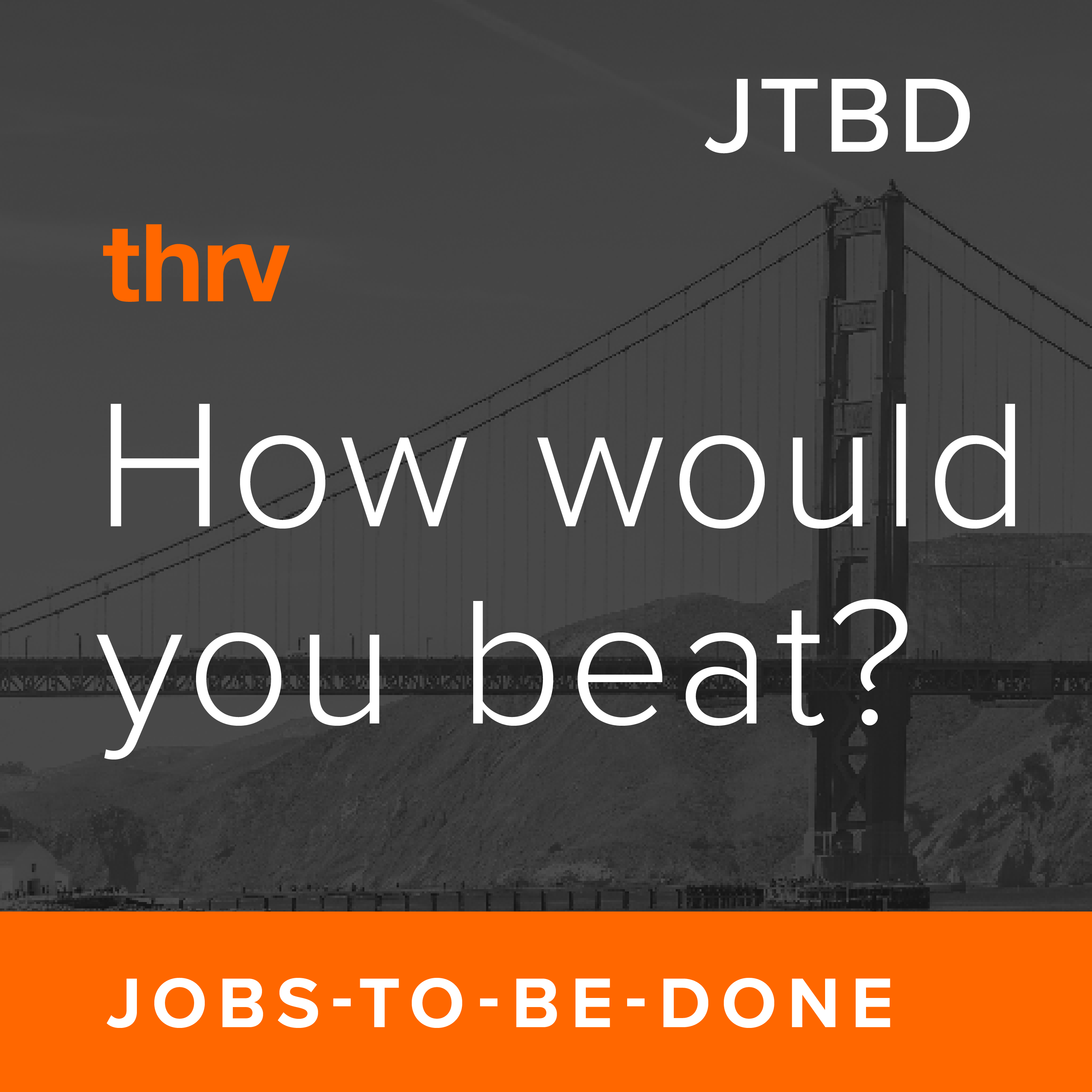February 28, 2017
Pitch Like a Startup to Win Budget at Your Big Company
Many people think that only entrepreneurs need to pitch investors and raise money, but the same process is happening every day in big companies. Boards, executives, and stakeholders are trying to determine how to allocate funds just like venture capital firms and angels. As a product manager or department head in an enterprise, you need budget to fund your projects and ideas. Just like an entrepreneur, you need to craft a compelling story that demonstrates your project will generate more money than is put into it.
But what makes a good pitch?
Our Product Pitch Cheat Sheet shows you.
We've combined top venture capital firm Sequoia Capital's Writing a Business Plan--the outline of the story they need to hear to invest--and the Jobs-to-be-Done product development method to generate a clear and concise guide to pitching a product idea.
Sequoia's outline tells you what to cover, and Jobs-to-be-Done helps you answer the key questions that will give you confidence in your material, such as:
- How do you know your problem is worth solving?
- How do you know your solution is good enough?
- Is your market big enough?
Whether you're trying to find budget to launch a new product or initiative, get more resources for your team, or confirm for yourself that your project is worth pursuing, Jobs-to-be-Done can quantify the justification you need to win investment.
After the cheat sheet, you'll find Sequoia's outline with the JTBD guidance under each point. If you'd like to learn how to do all of this yourself in detail, don't hesitate to contact us.

1. State the Company Purpose
As Clay Christensen says, "your customers aren't buying your product, they are hiring it to get a job done." A "job" is an important goal that a person is trying to achieve in their personal or professional life, such as "reach a destination on time," "acquire a customer," or "overcome diabetes to achieve optimal health."
The struggle people feel in attempting to get their job done is what causes them to look for a new solution--a product to hire. We call people who are trying to get a job done "job executors." If your company gets the job done for the job executors, they will use your product.
A direct and simple way to state your company's purpose is to say what job you are getting done for which job executor.
Here are a few examples:

Try to make your articulation compelling and, as Sequoia says, "declarative." The job, the job executors and the key struggle should be very clear.
If you have chosen a job that has a lot of job executors trying to accomplish it frequently and the job is famously difficult to do well, it should be immediately clear that when your company achieves its purpose, it will create enormous value.
Finally, remember that your product is not part of your purpose. For example, if you're trying to help small businesses acquire customers, your purpose should not be to "build the fastest, easiest-to-use CRM." Small businesses don't want lightweight CRMs any more than they wanted advertisements in print directories. What they want is to get a job done, so express your purpose in terms that reflect helping people overcome the stress and anxiety associated with getting a job done.
2. State the Problem
Your customer's problem is that their job is complex and difficult to execute quickly and accurately. It could even require the use of multiple solutions.
How do you know if the pain is severe enough that people are looking for a new product to relieve it? Jobs-to-be-Done helps you quantify the pain and gives you a benchmark to know if the problem is worth solving.
The key is identifying the unmet needs. In Jobs-to-be-Done, we define customer needs as "the metrics customers use to judge how well the job is going." The metrics we use are speed and accuracy. If the job is slow and inaccurate, the customer will want a new solution.
You can interview job executors to find out what's frustrating and time-consuming about executing the job. Then, you can survey a statistically significant sample of job executors to determine which needs are the most important and least satisfied. These are your customers' unmet needs.
The unmet needs are the precise articulation of the customer's struggle to get the job done. Since a job is a key goal in a person's personal or professional life (i.e. they need to execute the job frequently and they derive value from doing it well), the unmet needs are problems worth solving--they have great value.
It's rare, but there are times when there are no unmet needs in a job. This means you don't have a problem worth solving. Often this is because you came up with your idea for a solution first and it's for a job that is over-served (the job is important but perfectly well satisfied in the market). This is a problem that's not worth attempting to solve, as no one is looking for a new solution.
But once you've found a collection of unmet needs, you have the problem you need to start a business. In your pitch you can say, "[job executors] are struggling to [job-to-be-done]." Then, you can state the key unmet need(s) you uncovered in the market and intend to serve with your product.
For example, if you were pitching Waze, here's how you could state the problem:

In this problem statement, the job executors are "drivers," the job is "reach a destination on time," and the unmet need is "reduce the time it takes to determine if you should take an alternate route due to traffic conditions."
Anyone who drove a car before Waze has felt this problem, which means if you state it well, it should resonate. More importantly, if you have executed Jobs-to-be-Done, you will have data to back up your statement. You will be able to show that this unmet need is worth attempting to solve.
3. Show the Solution
When presenting the solution, Sequoia says to "demonstrate your company's value proposition to make the customer's life better." In other words, how is your solution going to serve the job executors' unmet needs in the job and how do you know it will do it well enough for customers to switch to your solution from whatever they're doing today?
Using Jobs-to-be-Done, you can measure the value of your solution. Customer needs are all metrics of speed and accuracy. Consider how long it takes to meet your targeted needs and compare that time to the existing solutions. The closer your product gets to making the job automatic and extremely accurate, the more customer value you are adding.
Instead of talking about the features of your product, frame the discussion of your solution by how quickly and accurately it meets the needs in the job. For example, if the job is overcome diabetes to achieve optimal health and you're targeting unmet needs around reducing the time it takes to determine costs, benefits and risks of available options for the patient, then demonstrate how quickly your product enables patients to meet these needs.
4. Why now
Sequoia recommends setting up the "historical evolution of your category" and then defining "recent trends that make your solution possible."
Combining this with Jobs Theory, this becomes "What has changed that enables you to get your customers' job done better?"
Consider the following examples:
- iPod: There was finally a hard drive that small enough and inexpensive enough to hold "1000 songs in your pocket."
- Uber: Mobile devices were widespread enough that a market could be created to match passengers with drivers.
- Diabetes tracking apps: Regulations changed, requiring patients to have access to health information.
In the examples above, new technologies and changing regulatory environments enabled new and better ways to get the jobs done. If you look further back in history, we see that this has always been true. Think about those people that have solved a job for a large, underserved market at the right time. Some legendary examples include:
- Karl Benz: The potential of gasoline had just started being explored; people (and things) needed a way to get from point A to point B faster.
- Frank McNamara (the credit card): Consumer confidence in post-WWII America was rising; people needed to reduce the likelihood that not having cash on hand prevented them from buying what they needed.
- Jeff Bezos: In 1994, internet usage was growing by 2,300% per month and was an excellent foundation for serving the needs in the job "purchase a product" better than the existing solution of stores and mail order catalogues, which gave birth to Amazon.
During your pitch, be sure to identify recent trends that show why now is the time for your product or service. The people above tackled age-old jobs by capitalizing on technological advancements that made solving those jobs easier and faster.
5. Market size
Don Valentine, Sequoia's founder, has always stressed the importance of the market: "We have always focused on the market--the size of the market, the dynamics of the market, the nature of the competition--because our objective always was to build big companies."
When companies flounder, it's because they try to define the market based on product ideas rather than market needs. Then, they invest too much in the manifestation of their assumptions: their unwanted products. This is a gamble (and almost always a mistake), as it assumes there will be a line of customers waiting to use that product simply because it exists.
Before you take your product to investors, Sequoia says to calculate market size. But how do you do it? You have to carry out research to see how many people need to complete the main or related jobs your product completes. Remember: the job-to-be-done is the market—not the product.
This is why the traditional ways of examining a market are flawed. These include the following:
- Total Addressable Market (TAM): All units sold in a product category multiplied by the price per unit.
Served Available Market (SAM): Units sold of a specific product type multiplied by the price per unit.
Share of Market (SOM): Percentage of customers buying a certain company's products.
These are product-based ways to calculate market size. Jobs Theory teaches you that the target market is the job executors and a job-to-be-done.
As an example, consider the Microsoft Zune, which was an answer to the iPod. Using traditional ways of analyzing market size, Microsoft measured the iPod market, which, at the time, was in the billions of dollars (e.g. 200 million iPods sold x $150 per unit = $30 billion market). But in 2007, the iPhone and Pandora launched, getting the job of curating music done more effectively, and the the iPod market quickly dipped to $0.
Microsoft made the mistake of defining the market based on the product. The market vanished because it was defined by a product. This left Microsoft trying to grab a market share of what was essentially nothing.
Instead, with Jobs-to-be-Done, the market size should be defined based on the customer's willingness to pay to get the job done (regardless of the products currently in the market). To size the market into an accurate dollar amount, survey customers in the market to find out how much they are willing to pay to get the job done more accurately, efficiently, and/or conveniently. The resulting number is termed the securable market—the revenue you can generate by enabling customers to get a job done better.
6. Competition
As Sequoia says, it's "better to identify all the competitors than have the investors discover them afterwards." How do you capture a comprehensive list that is meaningful? Which products are worth including and how do you analyze them to show that your solution can beat them?
The competition is not just similar products. It is any existing solution--a product, service, or manual process--that the job executors use to get the job done today. This view generates a much broader list and a more comprehensive understanding of what your product needs to beat.
You can show how you will beat them by eschewing the traditional feature-to-feature comparison and instead looking at how well the competition serves the needs in the job. Your customers don’t want more features, they want to get the job done, so showing that your product has more features does not demonstrate that people will adopt it.
Let's look at the Nest learning thermostat as an example.
A typical list of competition would include other thermostat companies such as Honeywell and Emerson. The first version of the Nest didn't include all of the features of the Honeywell programmable thermostat and it was far more expensive, so how could you have shown that it would succeed?
First, identify the customer's job by asking, "What job is the customer hiring this product to get done?" In this case, it's to "achieve comfort in the home."
Next look at the needs in the job. One need is "reduce the likelihood of the home being cold when you return to it." How quickly and accurately does a programmable thermostat serve this need? Programming the thermostat takes minutes. The schedule is rigid, so if you get home early one day and forget to turn the thermostat up, you will be cold. The time it takes is minutes and the accuracy is low. The Nest improved upon this need by controlling the thermostat based on your location. It doesn't require programming so it meets the need faster. It's more accurate because it will turn on the heat automatically when you are home.
By showing how much faster and more accurately your product meets the needs in the job, you can show that you will beat the competition.
7. Product
Sequoia recommends you provide a product development roadmap covering functionality, features, architecture, intellectual property, form factor, etc.
Whether your product is far enough along to show a demo or all you have is a road map of your future, be sure to focus this section of your pitch on the unmet needs. It'll frame your story, giving your feature set meaning and showing why customers would switch to your product.
It's critical to demonstrate how early versions of your product will serve unmet needs better than the competition. Otherwise, your audience will question why and how you will get early adoption.
In your roadmap, you can show how even though your product only gets a few needs in the job done today, over time it'll expand to get the whole job done (and potentially expand to adjacent jobs), creating more value for the customer and a competitive moat.
8. Business model
Sequoia's outline recommends discussing your revenue model, product pricing, average value of a customer, sales and distribution model, and customer pipeline list. Here, you must make clear who is willing to pay (and how much).
The examples of Airbnb and Facebook show how viewing your business through the lens of Jobs Theory can help you construct a sound revenue model.
Airbnb generates revenue from the job executors of the two primary jobs the product set out to serve from day one:
1. Travelers finding lodging
2. Residents providing short-term rentals
Airbnb charges a fee on the transaction because the job executors have a willingness to pay to get these jobs done.
Facebook doesn't make money off the primary jobs it originally helped its users complete: students getting to know their classmates and staying in touch with friends and family. Instead, the mountains of user data Facebook collects created an asset to get another job done: businesses acquiring customers. The willingness to pay for this second job done is very high.
When conceiving your revenue model, first research the willingness to pay for the primary job your product gets done. If the job executors are not willing to pay for it, consider whether or getting the primary job done creates an asset that can be deployed to getting an adjacent job done where the job executors have a high willingness to pay.
Final Advice
Jobs-to-be-Done not only provides a rigorous foundation for your pitch, but it also provides a framework for you to determine if your idea is worth pursuing or to find a new idea worth pursuing. However, just because you've learned the language of Jobs, Job Executors, and Unmet Needs does not mean the audience for your pitch (company stakeholders, your company's board, potential investors) knows this language. Abstract your story from the theory to drive your points home. No one needs to know what a job or a job executor is to understand that drivers struggle to reach a destination on time. Use the theory to do your homework and then tell your story in plain English.
Posted by Jared Ranere View all Posts by Jared Ranere





